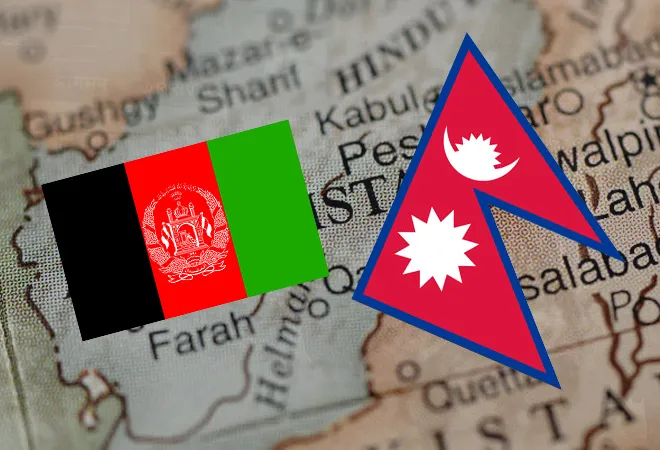
In Afghanistan, the political structure crumbled and the socio-economic status of the people met a major setback leading to a humanitarian crisis after the Taliban returned to power in August after two decades. To maintain peace in the land, the US dropped 80,000 bombs during 20 years of war in Afghanistan in which hundreds of thousands of people were killed and as much as US $
2.3 trillion was spent. But ultimately, the American-backed Ghani government in Afghanistan was ousted from the country due to its inactivity.
In such a precarious situation, the Taliban government is impatient to get legality from the international community. However, none of the governments so far has given official recognition to this regime. Toeing the line of the international community, Nepal also adopted a wait-and-see policy in the matter of extending legal status to this government. It treats the political developments of Afghanistan purely as an
internal affair of this country.
Though Afghanistan is far off from Nepal, lying at an aerial distance of around 1,700 kilometres, both of them are members of the South Asian Association for Regional Cooperation (SAARC). They have been maintaining diplomatic relations irrespective of the fact that they don’t have a diplomatic mission in each other’s countries.
Despite the political instability in Afghanistan, this country happens to be one of the preferred choices of work destination for many Nepalese workers. Over the years,
8,000 Nepalese workers were issued labour permits for Afghanistan. Estimates are that
undocumented Nepalese labourers working in Afghanistan could even exceed 14,000.
Though Afghanistan is far off from Nepal, lying at an aerial distance of around 1,700 kilometres, both of them are members of the South Asian Association for Regional Cooperation (SAARC).
The Nepalese Gurkhas hired by private companies earned the credibility for
providing security to sensitive offices in Afghanistan, including the
diplomatic missions of Canada, Germany, the UK, and Japan. They were also deputed there by private companies to provide security to the United Nations’ (UN) specialised agencies in Kabul.
Many of the Nepalese in Afghanistan were evacuated by the Nepal government following the seizure of power by the Taliban in that country. Reports are that Nepal evacuated most of its citizens from Afghanistan up until September 18, but still, some
300 Nepalese working in different UN agencies are still there.
While the Nepalese managed to reach Afghanistan for job prospects, the Afghans, of late, have also started arriving in Nepal illegally. Many Afghan families have entered Nepal, including Kathmandu, with the hope of being granted asylum.
Because Afghanistan and Nepal have no common border, the Afghans first enter India and then through the help of brokers, they cross the porous Indo-Nepal border and enter into Nepal without having any visa or other legal documents. Often, the Afghans have to pay
US $ 1,000 to 2,000 for each family member to enter Nepal through illegal channels.
Most of the Afghans who seek refugee status in Nepal have come from the Kandahar region of Afghanistan.
It is not that Afghans have only been entering Nepal after the victory of the Taliban in Afghanistan; they entered Nepal illegally even prior to that. Sometime back, the UNHCR had credibly identified
53 Afghan asylum seekers of 13 families at Samakhusi locality in Kathmandu. This was possible because of the concentration of Afghans in the Samakhusi locality, which is known as
Little Kabul.
Most of the Afghans who seek refugee status in Nepal have come from the
Kandahar region of Afghanistan. However, the government of Nepal has not provided them refugee status, but at the same time, they have not been ousted from the country.
Recently, Nepalese security personnel arrested 11 Afghan nationals from the Sinamangal locality of Kathmandu as they entered the country illegally through India’s Sunauli border route. Subsequently, they were
handed over to the emigration department for further action. It is largely believed that many of the Afghans might have entered Nepal and are not only in Kathmandu but also other townships of Nepal. Understanding the seriousness of the situation, the Home Ministry of Nepal warned the people
not to rent their rooms, houses, or apartments to anyone without identifying their origins and legal papers. As if this was not enough, the security agencies of the country have also intensified their vigilance at the Nepal-India border.
Apart from the Afghan refugees, Nepal is also home to more than
3,000 Rohingya Muslims from Myanmar and refugees from Somalia and Pakistan. Of the total number of Rohingya Muslims in Nepal,
400 of them have been living in Kapan in the northern outskirt of the Kathmandu Valley.
In the 1990s, more than
100,000 Bhutanese refugees entered Nepal. Later on, many of them were made to settle in Canada, Australia, the US, Norway, New Zealand, Britain and other countries. On top of this, over
20,000 Tibetan refugees have been living in this country after the political uprising in 1959.
The government of Nepal has imposed a system whereby the Indian people will have to produce identity cards starting 31 October 2021 while entering Nepal through the land border.
Realising the seriousness of the situation, the security agencies of Nepal and India increased vigilance, especially along the border regions to prevent and counter any possible violence erupting from the Afghan crisis. The government of Nepal has imposed a system whereby the Indian people will have to produce identity cards starting 31 October 2021 while entering Nepal through the land border. As if this was not enough, the Nepalese authorities have also requested their counterparts in India to impose a similar system for the Nepalese, who cross the land border to enter into Indian territory.
Any attempt to curb the movement of Nepalese and Indian citizens from one country to the other could affect traditional socio-cultural and economic relations, especially amongst the border inhabitants of the two countries who until recently used to cross the border without any frills. The trade and commercial relations between the two countries could equally be affected due to such developments. Therefore, to minimise the possible risks from the Afghan crisis, Nepal needs to coordinate and cooperate with the security agencies of India, in particular, and with other concerned countries, in general, to prevent the Afghans at the source from entering into Nepal rather than creating hurdles on the free flow of citizens of the two countries in the name of regulating the border for this purpose.
The views expressed above belong to the author(s). ORF research and analyses now available on Telegram! Click here to access our curated content — blogs, longforms and interviews.



 In Afghanistan, the political structure crumbled and the socio-economic status of the people met a major setback leading to a humanitarian crisis after the Taliban returned to power in August after two decades. To maintain peace in the land, the US dropped 80,000 bombs during 20 years of war in Afghanistan in which hundreds of thousands of people were killed and as much as US $
In Afghanistan, the political structure crumbled and the socio-economic status of the people met a major setback leading to a humanitarian crisis after the Taliban returned to power in August after two decades. To maintain peace in the land, the US dropped 80,000 bombs during 20 years of war in Afghanistan in which hundreds of thousands of people were killed and as much as US $ PREV
PREV


